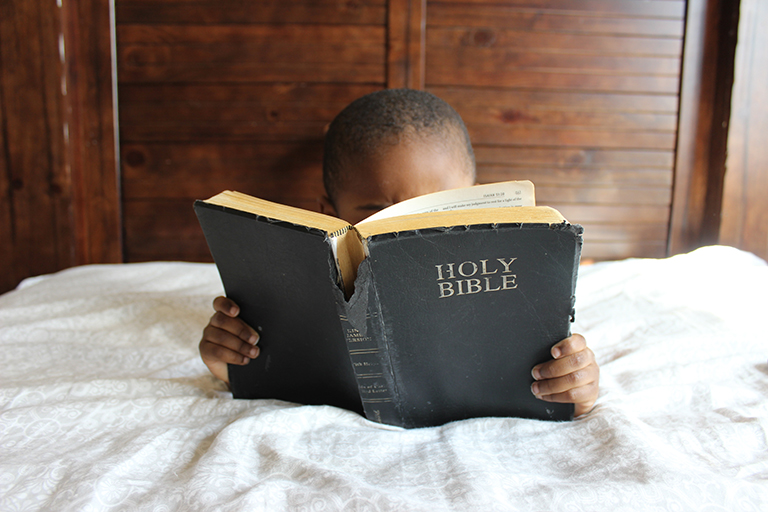
Reading the Bible with kids can feel daunting. We can feel unsure of how to go about it, especially in the midst of our doubts about Scripture. Maybe we’ve simply used up all the tools we have and feel bored along with our kids. We’re here to help! We’ve put together some fantastic ways of reading the Bible with kids that will inspire you and your children to dig deep together. Much of the following is adapted from Faith at Home by Wendy Claire Barrie who devotes an entire chapter to studying scripture with kids. Check it out! If you missed our review of her book, go here!
Reading the Bible with Kids
First, it’s important to know what’s appropriate for the developmental stage of your child(ren). Not surprisingly, like physical and cognitive development, spiritual development has been researched and mapped. Although no person fits into the prescribed mold exactly, understanding how the brain’s development integrates with the blossoming of faith at various ages can be helpful. Some ways of engaging scripture are just simply going to be better for some ages than others. Human Development and Faith by Felicity B. Kelcourse is a helpful reference, especially when understanding that the theory isn’t directly applicable to every person at any given age but is more a guideline.
Bibles for Kids
Storybook Bibles are those that tell a selection of Bible stories. Children’s Bibles are those that include the entirety of the Bible with illustrations and commentary. Parents, be aware of the theology and information any commentary boxes provide. And read through it prior to giving it to them. What is presented as fact may not be.
There are several options out there to choose from. It takes a discerning eye to find the one or few that fit with your theology. And, as parents, we must be intentional and engaged in our decision of what we upload to our children’s hearts and minds. Stay tuned for a future post here on our blog where we will be reviewing children’s Bibles! Until then, know what your kids are reading and steer clear of those with which you don’t feel comfortable.
Audio Bible
Another idea that may turn out to be helpful is listening to the Bible in the car on drives. Whether heading out for a few quick errands or on a long road trip, an audio Bible can be a great way to get reading in amidst a busy schedule. Pause the reading if good discussion or questions arise. Additionally, weaving the Bible into everyday tasks like driving can assist children in taking their faith into their week beyond Sundays.
Remain Open While Reading the Bible with Kids
Remain open to your children’s interpretations and thoughts. Refrain from correcting unless entirely necessary. And avoid simply responding with a value statement like, “Oh, I like that idea you had.” or “Good thinking.” Rather, ask follow-up questions or say something like, “You know, I’ve never imagined that before” or “Hmm, tell me more about that idea.” These responses help children stay present in their own discovery rather than on their performance for you.
This process is not so much about being right or wrong. It’s much more about nurturing an inquisitive relationship with scripture. Though sharing the answers we do know is invaluable for children, much of life is ambiguous. There’s much about God and ourselves we cannot explain. It’s important for children to have an established theology that includes this. Otherwise, it’s likely that either there will be much pain in the loss of a neat and tidy theology, or the child will see no reason to preserve something they’ve found to be untrue as a young adult.
Interpret Creatively Together
While reading Bible stories together, invite your children to discover meaning in the text by wondering with them similar to the Montessori-based approach of Godly Play. This process of open-ended conversation with each other will expand both you and your child. Discuss things like: “What is your favorite part? Where do you see yourself in this story? Where might God be in this story? Could any part be left out? Where might this really be? What part is the most important?”
Give Space for Response
Children will often want to somehow work with the stories they’ve heard. This can be through visual art like painting, drawing, or sculpting. Your child may want to journal about what they’ve read or heard. Perhaps they like acting things out; be an eager participant if they invite you into their production. The stories they’ve heard may come out in their game-playing, block-building, or their dinner table conversations. Be ready to assist them in their striving to make sense of, and integrate, the stories they’ve uncovered. Do this easily by providing them with the materials they need when possible and a safe space to tell and retell the stories of their faith.
Praying with Scripture
One way of reading scripture with kids is using it as a prayer practice. For example, help your child pick a verse that will be their prayer for the week, month, year. Even better if you have a verse, too! As you read through the Bible with your children, keep an eye out for verses that stand out. Talk about why and whether that verse could be a good prayer to memorize. Then write the verse and post it in a place your child will notice it regularly; the bathroom mirror, the computer screen or on their binder are all great spots. This way, they will have an easier time committing it to memory.
Ideas for Older Children and Youth
Comparing Bible Translations
Having a few Bible translations in the house or church can be a great way to engage children and youth. Across translations, there are differences of language that can influence meaning and interpretation. Showing this to kids encourages their freedom in translating it for their own lives. Additionally, it allows for them to understand the process of translating sacred texts. Then they are challenged to think critically about various perspectives even within their faith tradition.
Understanding the Wider Picture
The New Oxford Annotated Bible is a great companion to have when reading the Bible with kids young and old. Also, Introducing the New Testament: A Historical, Literary, and Theological Survey by Mark Allen Powell is an easy-read and fantastic for background. Additionally, The Bible Project produces videos available on YouTube that give accurate contextual information about Bible stories and topics in a compelling way. Lastly, Women’s Bible Commentary, Third Edition by Newsom, Ringe, and Lapsley, offers voices less often read in the more “standard” commentaries.
We’d love to hear how you are reading the Bible with kids. Share what’s working in the comments below!





Hilary says
I look forward to reading your reviews of Children’s Bibles.
Abby says
I am curious of your suggestions for audio bibles. We have the Jesus storybook CD’s but I’m curious if you have other recommendations!
Thanks!